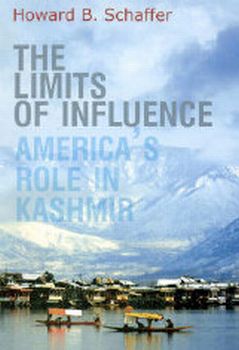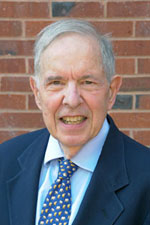Career diplomat and one of the many South Asian experts in US Howard B Schaffer’s just released book ‘The limits of influence’: America’s role in Kashmir, sketches Washington’s moves to settle the Kashmir dispute from “1948 to 2009 present”. Sara Wani reviews the book
 The author has divided the American involvement in three phases. The first phase which he calls deep US involvement stretching from 1948 to 1963, second phase: a quarter century (1964-89) of American diplomatic quiescence, and finally the third phase of “crisis management” from 1990 to present.
The author has divided the American involvement in three phases. The first phase which he calls deep US involvement stretching from 1948 to 1963, second phase: a quarter century (1964-89) of American diplomatic quiescence, and finally the third phase of “crisis management” from 1990 to present.
Published by the Washington based think tank Brookings Institution Press, the book gives details of American moves and personal efforts of its Presidents from Truman to Johnson to make the two countries come around and settle this nettlesome issue. It is dotted with the US role in all draft UN resolutions asking for demilitarization and consequent plebiscite under international supervision. It gives a peep how US tried to woo Nehru into dialogue between the two warring nations to sort out the entangling Kashmir tangle, offering mediation and backtracking with Nehru baring teeth and spiting venom, threatening to join Soviet Union.
Schaffer gives a rearview of chest beating Pandit Jawahar Lal Nehru at UN wishing the world to look from his eyes, something both American and Britons refused to do. It gives an impression which can fully be substantiated by the pages of history that Nehru never wished to part with Kashmir, and his promise to Kashmiri people in Lal Chowk in 1948 with Sheikh Abdullah on his side that question of Kashmir accession would be settled once peace is restored in the state was nothing but a charade. In his scheme of things there was no turning back and he did away with every one whom he suspected of spoiling his broth. Rather, Nehru had decided as early as in 1936 when he managed to secularize the Muslim Conference and got it infiltrated by his men. Nehru was obsessed with Kashmir throughout and saw Kashmir as a piece of real estate. India with Nehru at the helm blocked every effort to settle the dispute and eventually made it a ‘cold war issue and ensured a Soviet veto on any Security Council resolution unacceptable to India. As early as in 1949 Nehru told US ambassador to India Loy Henderson that “so far as Kashmir is concerned he would not give an inch. He would hold his ground even if Kashmir, India and the whole world would go to pieces.”
Nehru, Schaffer’s book suggests found fault with every UN and US move to settle the dispute. And for a brief movement in 1962 when Chinese deflated his ballooning ego did he pretend to listen to reason if Pakistan is forced “not to stab India in the back”. Americans promised Ayub Khan a settlement if he showed restraint. India backtracked once China declared unilateral ceasefire making Ayub to blow hot and cold. The 1965 war pronounced almost end of US intervention in the region as Pakistanis accused them of betrayal for not coming to their rescue as a security alliance partner and India raised hue and cry that American supplied Patton tanks were used against. American’s cursed both parties and repented for wasting its resources, while gaining nothing except ill will of both the countries.
With war of 1971and dismemberment of Pakistan and subsequent Shimla Agreement, Kashmir issue was almost shelved and the author writes that in an one-on-one meeting Bhutto had agreed to partitioning of Kashmir and turning the line of actual control into international border
The current phase of US intervention in solving Kashmir got a start with 1989’s indigenous uprising in Kashmir valley. India accusing Pakistan of fishing into troubled waters started biggest ever military maneuvers ‘operation brasstacks’ forcing Pakistan deployment along the borders. With tempers flaring, US sent Robert Gates, its deputy national security advisor to calm the situation.
The Kargil war again made US administration to intervene and call for withdrawal of forces. Clinton assured Nawaz Sharif of personal help in kick starting the Indo-Pak peace process as quid pro quo. With Nawaz out and Musharraf in as part of a classis military coup, a hallmark of Pakistan since its inception, things remained where they were. Even Bill Clinton failed to offer anything during his visit to India and Pakistan in 2000 but a rebuff to Pakistan for their adventurism in Kargil. Nuclear tests by both India and Pakistan in 1998 reinforced the need for permanent settlement of the Kashmir dispute. With Clinton gone and 9/11, Pakistan again allied with US in its war against terrorism. Bombing of Kashmir’s state assembly and attack on Indian Parliament made Colin Powel, Richard Armitage and Donald Rumsfeild to balm the hurt and call for restraint.
The book vividly recalls the American intervention in the local events which started with the release of Rubaiya Syeed, the daughter of then Home Minister Mufti Mohammad Syeed, who was kidnapped by JKLF militants. The US administration intervened and “strongly urged Pakistan to intervene with Rubiya’s captors to secure her release. The Pakistanis assured the Americans that they have already done so”.
During these turbulent times, although US lectured New Delhi on civil liberties but could do little to achieve on this count on ground. Some senators tried to link American aid to India with its good behavior in Kashmir as was done many at times during 1950’s and 1960’s, U S administration never concurred.
 The book recalls the tasting of terrorism when shadowy al-Faran kidnapped six foreign trekkers including two Americans. The American, British, Norwegian and German diplomatic missions along with Federal Bureau of Investigation (FBI) maintained their presence in Kashmir. FBI remained in Kashmir for four long weeks without being able to trace the kidnapped foreigners. Even US Army’s crack Delta Force and elite British and West German counterterrorism groups mounted secret missions”.
The book recalls the tasting of terrorism when shadowy al-Faran kidnapped six foreign trekkers including two Americans. The American, British, Norwegian and German diplomatic missions along with Federal Bureau of Investigation (FBI) maintained their presence in Kashmir. FBI remained in Kashmir for four long weeks without being able to trace the kidnapped foreigners. Even US Army’s crack Delta Force and elite British and West German counterterrorism groups mounted secret missions”.
Delhi Bureau chief of New York Times later reported that al-Faran was a RAW operation but American officials did not buy the theory saying that “if RAW ever contemplated a covert action programme that involved kidnapping an Amertican, they would have realized that it was a virtual certainty that we would have discovered it and that would have killed it dead”.
The third phase of US intervention in Kashmir involved Kashmir too. Recognizing them as actors, American administration patronized Kashmir Study Group, Kashmir American Council to sort a way out for resolution of this long pending issue which may anytime in future devour the whole of South Asia.
The most absurd thing during first and mostly second phase of US activism in connection with settlement of Kashmir discord was lack of rapport between the US ambassadors in Delhi and Karachi, each trying to sell other sides’ ideas and viewpoints. The book portrays them more as lobbyist than career diplomats. But the third phase of US intervention in Kashmir witnessed diplomats in two countries behaving more professionally.
The book seems to ascribe failure of US diplomacy in settling the Kashmir issue to Nehru’s unwillingness to part with Kashmir and political instability and lack of strong leadership in Pakistan coupled with opportunist and small men thrown in big chairs in Kashmir who lacked vision and perspective to lead people to right path, the path which would have led to peace and development in the whole of sub-continent.















